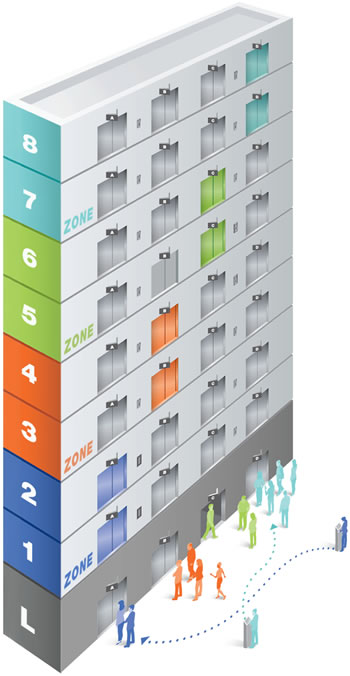Elevator handling capacity is defined as the amount of passengers that can be adequately served by an elevator system in five minutes. Sometimes quoted as a percentage of the building population, other times stated as a specific number of people, a higher handling capacity means serving more passengers in less time. While handling capacity can always be increased, at least in theory, by using more or bigger elevators, elevator manufacturers are always looking for ways to increase handling capacity without changing the underlying elevator configuration. In other words, how can you serve more people with the same physical elevators — without changing the size, speed or number of elevators?

Sophisticated software is allowing building managers to serve more people with the same physical elevators — without changing the size, speed or number of elevators. (Image: Otis)
The answer lies in elevator software. When the behind-the-scenes computer software that controls the elevator’s behavior is reprogrammed to use new inputs, such as a passenger’s desired destination, and new outputs, such as specifically which elevator a passenger should board, handling capacity can be increased.
It is well known that destination entry elevator systems, in which the passenger enters his or her desired destination floor on a keypad, touchscreen or at a security gate in a hallway instead of using the traditional “up/down” buttons, significantly improve handling capacity when most of the elevator traffic is originating from the lobby floor, such as in the morning at an office building, for example. Destination entry systems not only know the destination of the prospective passenger, they also have the ability to communicate to the passenger which elevator to enter. With destination entry systems, a passenger no longer enters the first elevator to arrive and open its doors. Rather, the passenger waits for the specific elevator assigned to him or her.
When passengers can be assigned to specific cars, the elevator system has the ability to group similar passengers into the same car. Usually, similarity is defined by desiring the same destinations. For example, passengers going to floors 5 and 9 might be put into one car, while passengers going to floors 3 and 8 might be put into another car. Instead of two cars stopping at four floors, each car will only stop at two floors, but the same number of people will be served. This approach assigns passengers to the same car until a predetermined number of passengers or number of stops or some combination of both has been met, before starting to assign passengers to another car.
Grouping by destination means that for any specific round trip, where round trip means a trip from the lobby to other floors in the building and back to the lobby, the individual car makes fewer stops with a greater number of passengers transferring at each stop. This leads to shorter round-trip times. Because the elevator gets back to the lobby faster, it is available sooner to serve more people. The result is increased handling capacity from the same set of physical elevators.
Otis Elevator Company has developed a proprietary software called SmartGrouping that assigns passengers going to the same floors, contiguous floors or nearly contiguous floors to the same elevator. With Otis’ software, in the previous example passengers going to floors 3 and 5 would be assigned to the same car, while passengers going to floors 8 and 9 would be assigned to the other car. This approach divides the building into sectors, assigning a specific car to handle all the demand to the floors in that sector. If one car is not sufficient for the traffic demand, another car will be assigned to the sector. Sector sizes are flexible and constantly adjust to traffic conditions. For example, if a large percent of traffic is going to a single floor for a period of 10 minutes, for that 10 minutes the relevant sector may contain only that specific floor and no others.
An evaluation of elevator motion dynamics reveals that when an elevator stops for contiguous or nearly contiguous floors, it spends less time in acceleration and deceleration states than if it were making the same number of stops separated by a large number of floors. Therefore, Otis’ software allows the elevators to spend less time cycling between the lobby and the necessary stops above the lobby. This reduces round-trip time, allowing even more round trips to be made within a given time period, and, ultimately, increasing the all-important elevator handling capacity.
Destination management systems and grouping software technology results in shorter round-trip times and increased handling capacity. But the software does more than that: Otis’ software actually tracks hall call entries and is sophisticated enough to determine when it is not needed, because when passenger demand is low, grouping may actually result in longer waits for passengers. In these instances, the destination management system is smart enough to defer to non-grouping methods.
Today’s sophisticated elevator control software is an effective way to improve prospective up from lobby handling capacities in potential buildings or increase current up from lobby handling capacities in existing buildings.
Theresa Muenkel Christy
Theresa Muenkel Christy, BA, MA, MBA is an Otis Fellow at Otis Elevator Company. She has over 25 years of experience in the vertical transportation industry. Her specific area of expertise is analyzing elevator configurations and dispatching performance via simulation and other methods.

